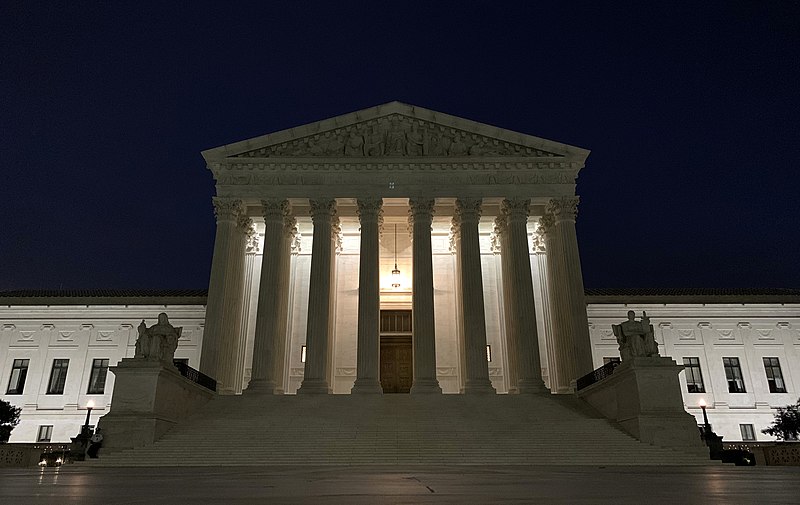
APK/Wikimedia Commons
On June 24, Dobbs v. Jackson Women’s Health Organization resulted in the overturning of nearly 50 years of precedent since Roe v. Wade. Many may have predicted this result as a product of a Roberts court mostly filled by Republican presidents or the rare leak of Associate Justice Samuel Alito’s majority opinion. However, the implications of the ruling remain confusing and impactful.
For centuries, the Supreme Court has remained an example to many of true justice and American exceptionalism, but it may just be beginning to flex its revisionist muscle. Such dominance may be a win for social Conservatism, but I remain skeptical of conservative judicial philosophy being displayed by the Dobbs decision. For a group that has historically embraced a love for constitutional law and respect for the precedent of the court, Alito’s opinion sounds a bit radical by conservative standards. The Conservative wing of the court has evidently begun its redesign of the past century of precedent.
Firstly, the Conservative dominance of the court points toward a nearly unstoppable stretch of true legal influence for veteran justices that, prior to Trump’s most recent appointments, were forced to spar with the scrappy pushback of a decorated living document-minded liberal wing of the court. As opposed to the originalist philosophy of more conservative judges, liberal jurists are most likely to see the Constitution as able to be interpreted, changing with society. With Justices Neil Gorsuch, Brett Kavanaugh and Amy Coney Barrett, the nearly unregulated body has no motivation to refrain from advancing more Conservative opinions into the foreseeable future — such as restricting gay marriage and other forms of contraception. This fact is one worth paying attention to, as such a divided court has not existed in recent history.
Let’s define some terms before we dive too deeply into the argument. For the purposes of this piece, small-c “conservative” will refer to those specifically with the belief that society shifts slowly and naturally. These traditional conservatives believe that society is too complex to sculpt manually and that drastic changes often come with unintended consequences. Alternatively, big-C “Conservatism” is more closely affiliated with a national party or movement; in this case, the U.S. Republican Party. Conservatism is more likely to be connected to social and religious values, differing from, say, Burkean conservatism, which is centered around an opposition toward overzealous policy. Nowhere in my argument will I make any qualitative judgments toward either ideology; I seek only to tie actions to the facts of these descriptions. The difference between the two types of conservatives, however, is often tied to how justices determine to rule based on their unique philosophies of judgment.
Judicial philosophy is ideally completely disconnected from personal political ideology. I could be staunchly pro-choice, but if I believed in judging as a constitutional originalist, then I might have dissented against the original Roe v. Wade ruling on the basis that there is no amendment that says “the right of the people to have an abortion, shall not be infringed” in the way there is one to “bear arms.” The exact same consistency of jurisprudence, the stable legal philosophy of its jurists, should be expected on the other side of the aisle and has often been championed by conservative Justices Scalia and Thomas. In Florida v. Jardines, a case investigating the arrest of a man caught growing marijuana by a police dog who stepped onto the man’s property before signaling the presence of the drug, Scalia and Thomas concurred with Justices Ruth Bader Ginsberg and Sonya Sotomayor, opposing their fellow conservatives’ belief that the search was lawful. Due to this high-level degree of judicial integrity being displayed in former cases, I am wary of the most recent court’s decision to overturn Roe.
Stare decisis, or the principle of following precedent, is a key element of consistency in judicial rulings at any level. Judges are supposed to factor in past rulings when issuing their opinions. Without precedent, each case could fall unpredictably whenever a new court is established. The only way that the public is to maintain trust in the court is to believe in jurisprudence. When judges rule invariably, legal activism is minimized. However, as is unusual for the Supreme Court, no true regulation exists to ensure such trustworthiness. They can rule however they want.
In Justice Kavanaugh’s concurring opinion, he celebrates (133) that “After today’s decision, the nine Members of this Court will no longer decide the basic legality of pre-viability abortion for all 330 million Americans.” While conservative values could lead a judge to justify the decision to overturn under an argument of small government and state’s rights, the recent revelation seems more likely to be a product of the court’s ideological majority. Even if the concurring justices claim to be acting in goodwill, insisting that the Constitution is neither pro-choice nor pro-life, I can’t help but agree with the dissenting opinion of Justices Breyer, Sotomayor, and Kagan, when they claim that “the Court reverses course today for one reason and one reason only: because the composition of this Court has changed.” For these reasons, we seem to be at the mercy of monarchs with robes and gavels.
As options for abortion and other recently enacted rights begin changing under this court, legislation becomes more important than ever. If this country is to join 64 others worldwide in offering safe, legal abortions, then it must do so through a constitutional amendment. Now is the time for actionable improvement. Rather than express dissatisfaction with the decision, all there is left to do is to volunteer and vote for local leaders. Until Congress garners enough support to pass national abortion laws, we will be living in a post-Roe country. The court has forced its hand, and the burden now falls on our lawmakers.
Ben Brodsky (25C) is from Scottsdale, Arizona.
The post The Supreme Court has begun redesigning a century of precedent, breaking from judiciary tradition appeared first on The Emory Wheel.
